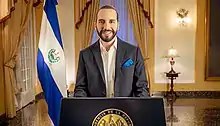Culture of El Salvador
The culture of El Salvador is a Central American culture nation influenced by the clash of ancient Mesoamerica and medieval Iberian Peninsula. Salvadoran culture is influenced by Native American culture (Lenca people, Cacaopera people, Maya peoples, Pipil people) as well as Latin American culture (Latin America, Hispanic America, Ibero-America). Mestizo culture and the Catholic Church dominates the country. Although the Romance language, Castilian Spanish, is the official and dominant language spoken in El Salvador, Salvadoran Spanish which is part of Central American Spanish has influences of Native American languages of El Salvador such as Lencan languages, Cacaopera language, Mayan languages and Pipil language, which are still spoken in some regions of El Salvador.
.jpg.webp)
.jpg.webp)
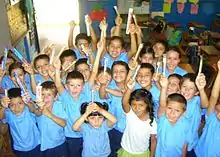
National Symbols
| Type | Symbol | Year | Image |
|---|---|---|---|
| Anthem | National Anthem of El Salvador |
1879 | |
| Motto | DIOS UNIÓN LIBERTAD |
 | |
| Flag and Coat of arms | Coat of arms of El Salvador and Flag of El Salvador |
1912 | 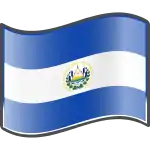 |
| Color | Cobalt blue and white
Additional appendages are in golden Amber (color) |
1912 | 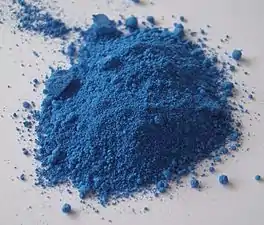 .jpg.webp) |
| Bird | Turquoise-browed motmot |
1999 | .jpg.webp) |
| Art | Fernando Llort style Art |
 | |
| Music | Xuc |
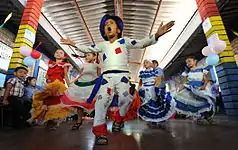 | |
| National Dish | Pupusa |
.jpg.webp) | |
| Flower | Yucca gigantea |
2003 | 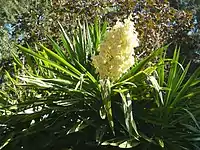 |
| Tree | Tabebuia rosea |
1939 |  |
| UNESCO World Heritage Site | Joya de Cerén |
1993 | _sm_(4290048784).jpg.webp) |
| Patron and National Personification | Monumento al Divino Salvador del Mundo |
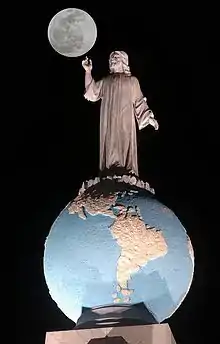 | |
Native Homeland
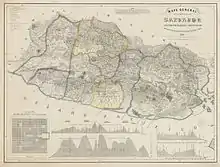
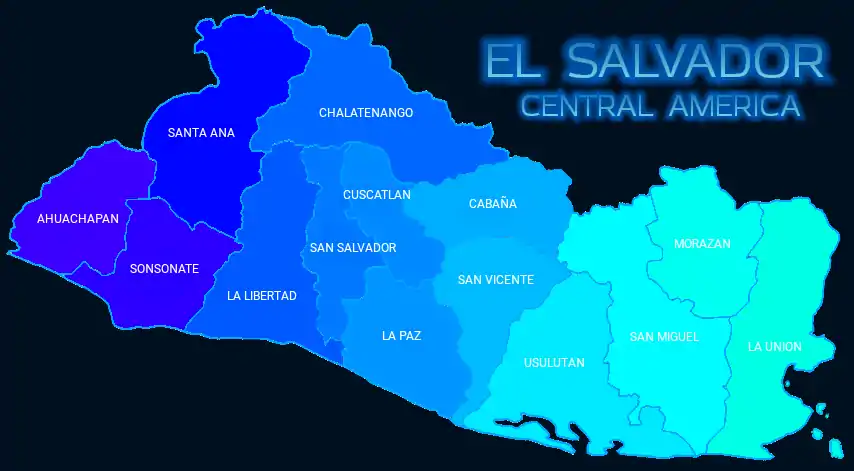
Salvadorans inhabit the lush Central American nation of El Salvador. El Salvador is one of the seven country in the giant isthmus of Central America. The surface of El Salvador features tropical forest, jungles, mountains, volcanoes, plains (savanna), rivers, lagoons, lakes, calderas and the Pacific Ocean. The forests of El Salvador contain a wide diversity of flora and fauna. El Salvador is a home to ecosystems, biomes, living, nonliving natural resources and also home to a plethora of diverse species. In terms of nonliving resources, El Salvador contains rich volcanic soil, fertile earth that gives life to lush vegetation. Native vegetation such as Yucca gigantea, Cassava, Fernaldia pandurata and Crotalaria longirostrata which are used in Salvadoran food. El Salvador also contains gold under its surface, however all type of mining has been abolished in El Salvador. The Native American indigenous ancestors of Salvadorans, have been living in the region for thousands of years. El Salvador is periodically hit with earthquakes and tropical storms, occasionally but rarely by cyclones.
Demonym
Salvadoreño/a in Spanish and in English Salvadoran is the accepted and most commonly used term for referring people of Salvadoran ancestry. However, both Salvadorian and Salvadorean are widely used terms in daily life by English-speaking Salvadoran citizens living in the United States and other English-speaking countries. Both words can be seen in most Salvadoran business signs in the United States and else where in the world. This is because the sounds "ia" and "ea" in Salvadorian and Salvadorean sound more closely to the "ñ" sound in the Spanish term Salvadoreño.
Centroamericano/a in Spanish and in English Central American is an alternative standard and widespread cultural identity term that Salvadorans use to identify themselves, along with their regional isthmian neighbours. It is a secondary demonym and it is widely used as an interchangeable term for El Salvador and Salvadorans. The demonym Central American is an allusion to the strong union that the Central America region has had since its independence. The term Central America is not only a regional cultural identity, but also a political identity, since the region has been united on various occasions as a single country such as the United Provinces of Central America, Federal Republic of Central America, National Representation of Central America, and Greater Republic of Central America. The same can be said for El Salvador's neighbors, specifically the original five states of Central America.
Nicknames

Salvi is an informal demonym referring to the Salvadoran people and their culture, specifically to overseas born Salvadorans in the diaspora located in the United States. The word is formed by Anglonization and taking the first five letters of the affectionate diminutive hypocorism form of Salvador (Salvita) to a shorten form "Salvi", with plural being Salvis. The slang term Salvi was coined and used for self-identification by the first generation wave of Salvadoran Americans born in the United States from parents who had escaped the civil war in the 1980s, and has been used as a term of endearment. The term has been widely used and is in mainstream usage particularly among younger members and masses of the Salvadoran American sector. The term Salvi is preserved in a very positive light when compared to its other older counterparts and predecessors such as Guanaco and Salvatrucha which have fallen into disuse among Salvadoran Americans, regarded as derogatory and negative. The term Cuscatleco is reserved for older generations of Salvadorans, specifically those born in El Salvador.
Outside the United States and especially within El Salvador itself the term Guanaco/Guanaca is still commonly used and isn't considered offensive. It's used much in the same way Salvi is used among Salvadoran Americans, it's regarded as a term of endearment among Salvadorans especially those within El Salvador itself.
Languages

In El Salvador, the official language is Central American Spanish. Less than one percent of the population speaks the Pipil language, in places such as Izalco and several other towns.[1] However, there is no obligation academically or socially today to learn it, and the language is more commonly spoken by the elderly. Amongst the pre-Columbia languages that still exist common to places such as Izalco and Cacaopera is Nawat Pipil. English is taught as a second language and is commonly spoken by business people, as the country is developing through globalization.
Salvadoran Spanish
Central American Spanish is spoken by the majority of the country's population. The language and pronunciation vary depending on the region.
Sports

The main sport played by Salvadorans is association football. The Estadio Cuscatlán in the capital San Salvador is the largest stadium in Central America, with a capacity of just over 45,000. The stadium is the home ground of the El Salvador national football team, as well as club teams Alianza FC and Atletico Marte
The main football clubs in El Salvador play in the Primera División de Fútbol de El Salvador, which is made up of the top ten clubs. Below the Primera División exists a second level or Segunda División, made up of 24 teams split into two groups of twelve. There is promotion and relegation between the two divisions at the end of each season.
Religion
- Cathedrals in El Salvador
 Iglesia El Rosario, San Salvador
Iglesia El Rosario, San Salvador

 Iglesia Don Rua, San Salvador
Iglesia Don Rua, San Salvador Iglesia El Calvario, San Salvador
Iglesia El Calvario, San Salvador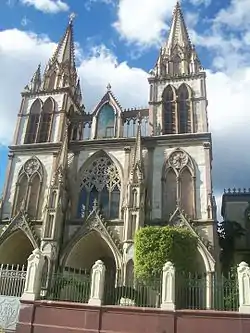
 Basílica del Sagrado Corazón de Jesús, San Salvador
Basílica del Sagrado Corazón de Jesús, San Salvador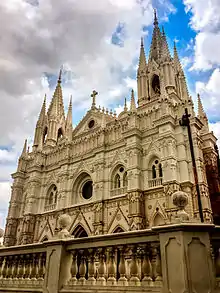
 Iglesia Santa Lucía, Suchitoto
Iglesia Santa Lucía, Suchitoto Church in Dulce Nombre de María
Church in Dulce Nombre de María Iglesia El Carmen, Santa Ana, El Salvador
Iglesia El Carmen, Santa Ana, El Salvador Iglesia Nuestra Señora de la Asunción, Ahuachapán
Iglesia Nuestra Señora de la Asunción, Ahuachapán

The Catholic Church has been the most prominent religious institution in El Salvador since colonial times, with nearly 75% of the population identifying as Roman Catholic. Reformed churches like Anglican, Lutheran, Pentecostal, and Baptists have experienced significant growth since the 1970s. Seventh Day Adventists, Mormons and Jehovah's Witnesses are also experiencing growth in the nation. Today, nearly 20% of the population belongs to one of these churches. Today, over 40% of El Salvador is Evangelical Christian. Small communities of Muslims, Jews, and Buddhists also exist in some parts of the country.
Costumes relating to religion
In El Salvador, there are different costumes used mostly in religious or other festivals, although in some of the older towns, they are still worn regularly. In female clothing, it is common to see elements like a scapular, a shawl, and a cotton headscarf with different coloured adornments.[2] These can be worn with a skirt and a blouse, or with a dress. The normal footwear is sandals. With male clothing, it is common to see a cotton suit or a cotton shirt, worn with modern jeans, sandals or boots, and a cowboy hat. However, these are rural fashions, and there can be many variations depending on the area.Also, 100% cotton shirts are commonly used (also known as guayaberas).[3]
Music
- Folkloric attire in El Salvador
.jpg.webp) Salvadoran girls in folkloric garb
Salvadoran girls in folkloric garb.jpg.webp) Young Salvadoran girls dancing traditional colonial music San Miguel, El Salvador
Young Salvadoran girls dancing traditional colonial music San Miguel, El Salvador
The music of El Salvador has a mixture of Lenca, Maya, Cacaopera, Pipil and Spanish influences, as well as Palestinian Salvadoran Arabic music and also African.
Music instruments that are present in El Salvador are Native American Pan-Indianism instruments such as Native American flute and drums, African instruments like xylophone, Güira and Mbira, European instruments like Guitar, pedal steel guitar, Fanfare trumpet and piano, Arab instruments like Oud, Ney, Goblet drum and Qanun (instrument). Religious Contemporary Catholic liturgical music instrument such as Tubular bells, Pipe organ, and Glass harmonica are also present.
This music includes religious songs (mostly used to celebrate Christmas and other holidays, especially feast days of the saints). Satirical and rural lyrical themes are common. Cuban, Colombian, and Mexican music has infiltrated the country, especially salsa and cumbia. Popular music in El Salvador uses Xylophone, tehpe'ch, flutes, drums, scrapers and gourds, as well as more recently imported guitars and other instruments. El Salvador's well known folk dance is known as Xuc which originated in Cojutepeque, Cuscatlan. Other musical repertoire consists of danza, pasillo, marcha and canciones.
Hammocks
- Hammocks in El Salvador
 Typical hammocks in El Salvador.
Typical hammocks in El Salvador.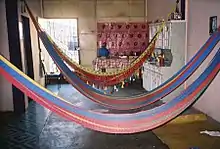 Three Salvadoran synthetic-thread hammocks in Morazán Department
Three Salvadoran synthetic-thread hammocks in Morazán Department
El Salvador is a hammock cultured country, and a large producer and exporter of hammocks. The valley in which San Salvador City sits upon is dubbed "The Valley of the Hammocks" because the Native Americans, used hammocks to repel constant earthquakes. Later, the colonizing Spaniards used the term as an allusion of earthquakes constantly rocking the valley where San Salvador City is, like a hammock. Hammocks are a big part of Salvadoran culture and are often used for afternoon naps. Hammocks swing from doorways, inside living rooms, on porches, in outdoor courtyards, and from trees. Just about everywhere a hammock can be seen hung in all social classes of Salvadoran homes. It is completely socially acceptable to lay around in a hammock all day in this Central American country, that hammocks can be seen from the most humble rural home, to the most prestigious city hotel chains, where there are the colorful and comfortable hammocks. To honor such a pleasure craft, the municipality of "Concepcion Quezaltepeque" celebrates its traditional Hammocks Festival, where artisans produce and sell hammocks as a tradition that begun in 1989 and has been celebrated every year since then, between the first and second weekend of November, it is “The Festival of the Hammocks”. Hammocks are sold in every corner in towns and cities.
Native American Heritage
Lithic era
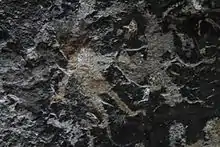

El Salvador was inhabited by Paleo-Indians, the first peoples who subsequently inhabited, the Americas during the glacial episodes of the late Pleistocene period. Their intriguing paintings (the earliest of which date from 8000 BC) can still be seen and marveled at in caves outside the towns of Corinto and Cacaopera, both in Morazán. Originating in the Paleolithic period, these cave paintings exhibit the earliest traces of human life in El Salvador; these early Native Americans people used the cave as a refuge, Paleoindian artists created cave and rock paintings that are located in present-day El Salvador.
The Lencas later occupied the cave and utilised it as a spiritual place. Other ancient petroglyphs called piedras pintadas (rock paintings) include la Piedra Pintada in San Jose Villanueva, La Libertad and the piedra pintada in San Isidro, Cabañas. The rock petroglyphs in San Jose Villanueva near a cave in (Walter Thilo Deininger National Park) are similar to other ancient rock petroglyph around the country. Regarding the style of the engravings it has been compared by with the petroglyphs of La Peña Herrada (Cuscatlán), el Letrero del Diablo (La Libertad) and la Peña de los Fierros (San Salvador). We can add to the list the sites in Titihuapa, the Cave of Los Fierros and La Cuevona both in ( Cuscatlán ).
Archaic Period
Native Americans appeared in the Pleistocene era and became the dominant people in the Lithic stage, developing in the Archaic period in North America to the Formative stage, occupying this position for thousands of years until their demise at the end of the 15th and 16th century, spanning the time of the original arrival in the Upper Paleolithic to European colonization of the Americas during the early modern period.
About 40,000 years ago the ancestors of the indigenous people of the Americas split from the rest of the world following the Pleistocene megafauna and then they flourish mightily, evolving in the Americas, from the Lithic stage to the Post-Classic stage, which was brought into an abrupt end about 525 years ago with the infamous mass genocide and cultural extinction caused by Europeans intrusion into the Americas, bringing deaseses and colonizing the Americas with warfare, terrorism, extremists radical Christianity and mass massacres. Only some Native American indigenous groups survived that catastrophe, most of them in Mexico, Central America and South America, with Salvadoran indigenous being one of many who have given rise to all modern Native Americans still alive today.
Mesoamerican-Isthmus cultures
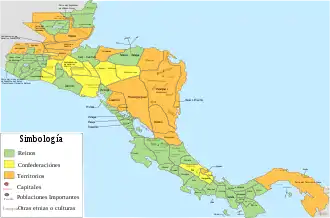
- Ancient Mesoamerican sites in El Salvador
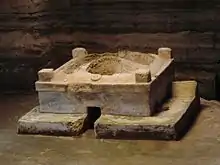



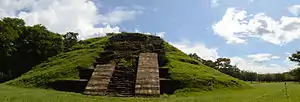
- Mayan artifacts of El Salvador
 Late Classic Maya cup from El Salvador. 600–900 AD.
Late Classic Maya cup from El Salvador. 600–900 AD. Mayan artifact found at the Joya de Cerén archaeological site
Mayan artifact found at the Joya de Cerén archaeological site Mayan artifact found at the Joya de Cerén archaeological site
Mayan artifact found at the Joya de Cerén archaeological site Late Classic Maya bowl, El Copador style, El Salvador.
Late Classic Maya bowl, El Copador style, El Salvador. Late Postclassic ceramic vessel from El Salvador, with face decoration. 1200–1520 AD.
Late Postclassic ceramic vessel from El Salvador, with face decoration. 1200–1520 AD. Late Classic Maya vessel from El Salvador, 600–900 AD
Late Classic Maya vessel from El Salvador, 600–900 AD Late Classic Maya plate, El Salvador.
Late Classic Maya plate, El Salvador. Late Classic Maya bowl from El Salvador.
Late Classic Maya bowl from El Salvador. Tazumal's Xipe Totec.
Tazumal's Xipe Totec.

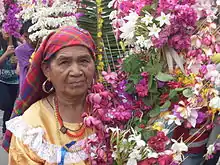
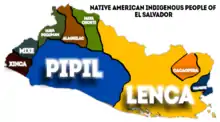
- El Salvador arts and crafts
 La Palma-type art, from La Palma, Chalatenango
La Palma-type art, from La Palma, Chalatenango Arts and craft from Ilobasco
Arts and craft from Ilobasco La Palma-type art form from Santa Ana, El Salvador
La Palma-type art form from Santa Ana, El Salvador Salvadoran staple art in La Palma, Chalatenango
Salvadoran staple art in La Palma, Chalatenango Mesoamerican souvenirs from Juayua
Mesoamerican souvenirs from Juayua Hand crafted bookmarks from La Palma.
Hand crafted bookmarks from La Palma. Handcraft Bag from Ataco
Handcraft Bag from Ataco.jpg.webp) La Palma-Style art on modern building in San Salvador
La Palma-Style art on modern building in San Salvador
Historically El Salvador has had diverse Native American cultures, coming from the north and south of the continent along with local populations mixed together. El Salvador belongs to both to the Mesoamerican region in the western part of the country, and to the Isthmo-Colombian Area in the eastern part of the country, where a myriad of indigenous societies have lived side by side for centuries with their unique cultures and speaking different indigenous languages of the Americas in the beginning of the Classic stage.
The Lenca people are an indigenous people of eastern El Salvador where population today is estimated at about 37,000. The Lenca was a matriarchal society and was one of the first civilizations to develop in El Salvador and were the first major civilization in the country. The pre-Conquest Salvadoran Lenca had frequent contact with various Maya groups as well as other indigenous peoples of Central America. The origin of Lenca populations has been a source of ongoing debate amongst anthropologists and historians. Throughout the regions of Lenca occupation, Lenca pottery is a very distinguishable form of Pre-Columbian art. Handcrafted by Lenca women, Lenca pottery is considered an ethnic marking of their culture. Some scholars have suggested that the Lenca migrated to the Central American region from South America around 3,000 years ago, making it the oldest civilization in El Salvador. Guancasco is the annual ceremony by which Lenca communities, usually two, gather to establish reciprocal obligations in order to confirm peace and friendship. Quelepa is a major site in eastern El Salvador. Its pottery shows strong similarities to ceramics found in central western El Salvador and the Maya highlands. The Lenca sites of Yarumela, Los Naranjos in Honduras, and Quelepa in El Salvador, all contain evidence of the Usulután-style ceramics.
The Cacaopera people are an indigenous people in El Salvador who are also known as the Matagalpa or Ulua. Cacaopera people spoke the Cacaopera language, a Misumalpan language. Cacaopera is an extinct language belonging to the Misumalpan family, formerly spoken in the department of Morazán in El Salvador. It was closely related to Matagalpa, and slightly more distantly to Sumo, but was geographically separated from other Misumalpan languages.
The Xinca people, also known as the Xinka, are a non-Mayan indigenous people of Mesoamerica, with communities in the western part of El Salvador near its border. The Xinka may have been among the earliest inhabitants of western El Salvador, predating the arrival of the Maya and the Pipil. The Xinca ethnic group became extinct in the Mestizo process.
El Salvador has two Maya groups, the Poqomam people and the Ch'orti' people. The Poqomam are a Maya people in western El Salvador near its border. Their indigenous language is also called Poqomam. The Ch'orti' people (alternatively, Ch'orti' Maya or Chorti) are one of the indigenous Maya peoples, who primarily reside in communities and towns of northern El Salvador. The Maya once dominated the entire western portion of El Salvador, up until the eruption of the lake ilopango super volcano. Mayan ruins are the most widely conserved in El Salvador and artifacts such as Maya ceramics Mesoamerican writing systems Mesoamerican calendars and Mesoamerican ballgame can be found in all Maya ruins in El Salvador which include Tazumal, San Andrés, El Salvador, Casa Blanca, El Salvador, Cihuatan, and Joya de Cerén.
Alaguilac people were a former indigenous group located on northern El Salvador. Their language is unclassified. The Alagüilac language is an undocumented indigenous American language that is now extinct. The Alaguilac ethnic group became extinct during the Mestizo process.
The Mixe people is an indigenous group that inhabited the western borders of El Salvador. They spoke the Mixe languages which are classified in the Mixe–Zoque family, The Mixe languages are languages of the Mixean branch of the Mixe–Zoquean language family. The Mixe ethnic group became extinct during the Mestizo process.
El Salvador has two Nahua peoples, The Mangue language people and the Pipil people. The Mangue people, also known as Chorotega, are an extinct Oto-Manguean language people, indigenous to eastern El Salvador border, near the gulf. The Pipils are an indigenous people who live in western El Salvador. Their language is called Nahuat or Pipil, related to the Toltec people of the Nahuatl Nation and were speakers of early Nahuatl languages. However, in general, their mythology is more closely related to the Maya mythology, who are their near neighbors and by oral tradition said to have been adopted by Ch'orti' and Poqomam Mayan people during the Pipil exodus in the 9th century CE. The culture lasted until the Spanish conquest, at which time they still maintained their Nawat language, despite being surrounded by the Maya in western El Salvador. By the time the Spanish arrived, Pipil and Poqomam Maya settlements were interspersed throughout western El Salvador. The Pipil are known as the last indigenous civilization to arrive in El Salvador, being the least oldest and were a determined people who stoutly resisted Spanish efforts to extend their dominion southward. The Pipil are direct descendants of the Toltecs, but not of the Aztecs.
Evidence of Olmec civilization presence in western El Salvador can be found in the ruin sites of Chalchuapa in the Ahuachapan department. Olmec petroglyphs can be found on boulders in Chalchuapa portraying Omlec warriors with helmets identical to those found on the Olmec colossal heads. This suggest that the area was once an Olmec enclave, before fading away for unknown reasons. The Olmecs are believed to have lived in present-day El Salvador as early as 2000 BC. The 'Olmec Boulder, ' is a sculpture of a giant head found near Casa Blanca, El Salvador site in Las Victorias near Chalchuapa. "Olmecoid" figurins such as the Potbelly sculpture have been found through this area, in fact most are described as looking primeval proto-Olmec.
Modern Native American people
According to the Salvadoran Government, about 0.23% of the population are of full indigenous origin. The largest most dominant Native American groups in El Salvador are the Lenca people, Cacaopera people, Maya peoples: (Poqomam people/Chorti people) and Pipil people.
The number of indigenous people in El Salvador have been criticized by indigenous organizations and academics as too small and accuse the government of denying the existence of indigenous Salvadorans in the country. According to the National Salvadoran Indigenous Coordination Council (CCNIS) and CONCULTURA (National Council for Art and Culture at the Ministry of Education ), approximately 600,000 or 10 per cent of Salvadorian peoples are indigenous. Nonetheless, very few natives have retained their customs and traditions, having over time assimilated into the dominant Mestizo/Spanish culture. The low numbers of indigenous people may be partly explained by historically high rates of old-world diseases, absorption into the mestizo population, as well as mass murder during the 1932 Salvadoran peasant uprising (or La Matanza) which saw (estimates of) up to 30,000 peasants killed in a short period of time. The 1932 Salvadoran peasant massacre occurred on January 22 of that year, in the western departments of El Salvador when a brief peasant-led rebellion was suppressed by the government, then led by Maximiliano Hernández Martínez. The Salvadoran army, being vastly superior in terms of weapons and soldiers, executed those who stood against it. The rebellion was a mixture of protest and insurrection and ended in ethnocide, claiming the lives of anywhere between 10,000 and 40,000 peasants and other civilians, many of them indigenous people. Many authors note that since La Matanza the indigenous in El Salvador have been very reluctant to describe themselves as such (in census declarations for example) or to wear indigenous dress or be seen to be taking part in any cultural activities or customs that might be understood as indigenous. Departments and cities in the country with notable indigenous populations include Sonsonate (especially Izalco, Nahuizalco, and Santo Domingo), Cacaopera, and Panchimalco, in the department of San Salvador
Arab Heritage
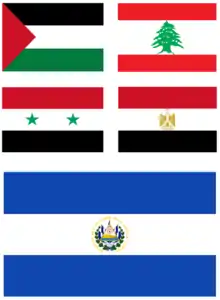
There is a significant Arab population (of about 100,000);[4] mostly from Palestine (especially from the area of Bethlehem), but also from Lebanon. Salvadorans of Palestinian descent numbered around 70,000 individuals, while Salvadorans of Lebanese descent is around 25,000.[5] There is also a small community of Jews who came to El Salvador from France, Germany, Morocco, Tunisia, and Turkey.
The history of the Arabs in El Salvador dates back to the end of the 19th century, because of religious clashes, which induced many Palestinians, Lebanese, Egyptians and Syrians to leave the land where they were born, in search of countries where they at least lived in An atmosphere of relative peace. There were also other reasons of a subjective nature, based on the hope of success, of achieving success and fortune and obtaining recognition from others.
It was not until the period between 1880s and 1920s, that the Arab migration began, when more than 121,000 people began to arrive in El Salvador, which at the time in 1879, El Salvador had a small local population of 482,400 and by 1920 El Salvador's population had grown to 1,168,000. These Arabs settled in the cities of San Salvador, San Miguel, Santa Ana, Santa Tecla, Usulutan and La Union.[6]
Arab immigration in El Salvador began at the end of the 19th century in the wake of the repressive policies applied by the Ottoman Empire against Maronite Catholics. Several of the destinations that the Lebanese chose at that time were in countries of the Americas, including El Salvador. This resulted in the Arab diaspora residents being characterized by forging in devoutly Christian families and very attached to their beliefs, because in these countries they can exercise their faith without fear of persecution, which resulted in the rise of Lebanese-Salvadoran, Syrian-Salvadoran and Palestinian-Salvadoran communities in El Salvador.[7]
Currently the strongest community is the Palestinian (70,000 descendants), followed by the Lebanese settled in San Salvador with more than 27,000 direct descendants, mostly (95%) Catholic and Orthodox Christians. The slaughter of Lebanese and Palestinian Arab Christians at the hands of Muslims, initiated the first Lebanese migration to El Salvador.[8]
Inter-ethnic marriage in the Lebanese community with Salvadorans, regardless of religious affiliation, is very high; most have only one father with Lebanese nationality and mother of Salvadoran nationality. As a result, some of them speak Arabic fluently. But most, especially among younger generations, speak Spanish as a first language and Arabic as a second.[9]
During the war between Israel and Lebanon in 1948 and during the Six Day War, thousands of Lebanese left their country and went to El Salvador. First they arrived at La Libertad, were they comprised half of the economic activity of immigrants.
Lebanon had been an iqta of the Ottoman Empire. Although the imperial administration, whose official religion was Islam, guaranteed freedom of worship for non-Muslim communities, and Lebanon in particular had a semi-autonomous status, the situation for practitioners of the Maronite Catholic Church was complicated, since they had to cancel exaggerated taxes and suffered limitations for their culture. These tensions were expressed in a rebellion in 1821 and a war against the Druze in 1860. The hostile climate caused many Lebanese to sell their property and take ships in the ports of Sidon, Beirut and Tripoli heading for the Americas.
Statistically in El Salvador, there are about 120,000 Arabs, of Lebanese, Syrian, Egyptian and Palestinian ancestry. In the case of these Arab-Salvadorans, although not all the families arrived together, they were the ones that lead the economy in the country.
In 1939, the Arab community based in San Salvador organized and founded the "Arab Youth Union Society"[10]
The Salvadoran Cabalgador (Cowboy)
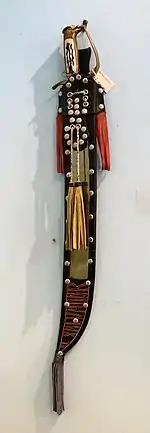

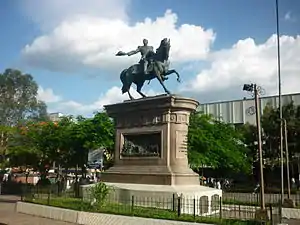
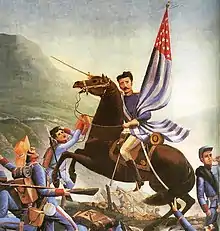
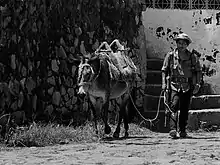

A Cabalgador (Spanish: Cavalry, Horseman, Horserider) is a Salvadoran horse-mounted livestock herder (cowboy) of a tradition that originated on the Iberian Peninsula and was brought to Central America by Spanish settlers. It has deep historic roots tracing back to Spain and the earliest European settlers of the Americas. Cabalgador is a Spanish word for a horseman rider and herder. It derives from Cabalgar and Cabalgadura meaning "rider". Early Cabalgadores in El Salvador were originally a mixture of part Spanish and American Indigenous, Mestizo, Indigenous and Pardo men who lived in the countryside and had a strong culture which has shaped El Salvador's over all distinctive rural culture, tradition, folklore, and music, having a strong rural countryside culture. The origins of the Cabagador tradition in El Salvador come from Spain, beginning with the hacienda system of medieval Spain. This style of cattle ranching spread throughout much of the Iberian peninsula and later, was imported to the Americas. During the 16th century, the Conquistadors and other Spanish settlers brought their cattle-raising traditions as well as both horses and domesticated cattle to the Americas.
The traditions of Spain were transformed by the geographic, environmental and cultural circumstances. In turn, the land and people of the Americas also saw dramatic changes due to Spanish influence. In El Salvador's case, a massive, almost complete deforestation to make way for agriculture and animal herding, El Salvador lost virtually all of its primary rain forests. The Spanish haciendas which in El Salvador's case were owned by a military middle class and wealthy military cavalry Spaniards who spoke in voseo, a Spanish speech that originates from medieval Spain, this way of speech is used by all Salvadorans today, Salvadoran Spanish which has shaped and defined Salvadorian-ism dating back to the 16th and 17th centuries.
Among common horse riders, there were also military and police Cavalry troopers called (Guardias) National Guard (El Salvador) who were infamously feared due to their abuse and unlimited use of power over the population, patrolling the rural areas keeping order. The Cabalgadores would prove to be vital up until the mid 20th century, especially for the military and the campesinos who would be influenced by the revolution, most of the guerrillas in El Salvador's civil war, were poor citizens who rode horses in the rural mountains.
Today being a Cabalgador is a symbol and idealized representative of machismo, virility and a display of either chauvinism but also with vestiges of chivalrous attitudes. They also are seen as poor campesinos (peasants), and are seen as people without manners or lacking the sophistication of an urbanite, akin to a redneck. However, being a campesino is also used in a neutral or positive context or self-descriptively with pride because it describes a humble and hard worker person.
Most male children in El Salvador as young as five are raised and began working in a cowboy atmosphere, working on ranches along with their fathers and older members of the family learning about agriculture and livestock, herding animals throughout much of El Salvador tending cattle, in an all-male environment which have also retain the machismo culture in El Salvador. Most men in El Salvador, particularly in the towns in the rural countryside including mayors wear elements of cowboy clothing. Cabalgadores in El Salvador dress in cowboy hats and carry machetes also known as Corbos in El Salvador, and they listen to nueva canción guitar type music.
Notable Salvadoran people
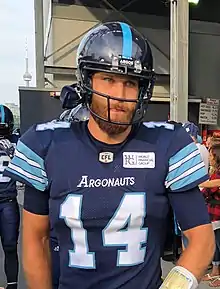 McLeod Bethel-Thompson is an American football quarterback who is a free agent. He played college football at Sacramento State.
McLeod Bethel-Thompson is an American football quarterback who is a free agent. He played college football at Sacramento State. Jorge Cañas was a Salvadoran football player.
Jorge Cañas was a Salvadoran football player.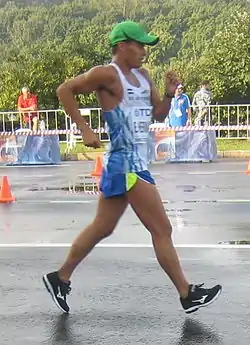 Emerson Hernández is a Salvadorean race walker.
Emerson Hernández is a Salvadorean race walker.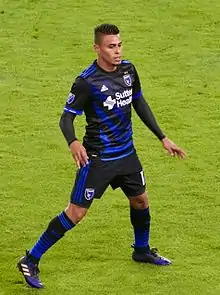 Darwin Cerén is a Salvadoran footballer who plays for the Major League Soccer club San Jose Earthquakes and is captain of the El Salvador national team
Darwin Cerén is a Salvadoran footballer who plays for the Major League Soccer club San Jose Earthquakes and is captain of the El Salvador national team Arturo Álvarez (footballer, born 1985) is a Salvadoran American footballer who plays as a winger and forward for Major League Soccer club Chicago Fire
Arturo Álvarez (footballer, born 1985) is a Salvadoran American footballer who plays as a winger and forward for Major League Soccer club Chicago Fire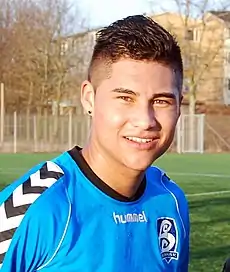 Dustin Corea is a Salvadoran international footballer who plays for FC Edmonton.
Dustin Corea is a Salvadoran international footballer who plays for FC Edmonton..jpg.webp) Eriq Zavaleta is an American soccer player who plays as a center back for Toronto FC of Major League Soccer.
Eriq Zavaleta is an American soccer player who plays as a center back for Toronto FC of Major League Soccer.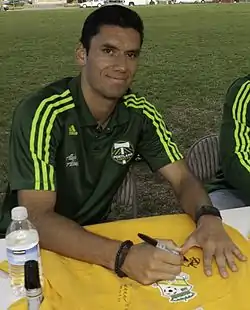 Steve Purdy is a Salvadoran American footballer who plays as a defender for Orange County Blues in the USL. He has played for the El Salvador national team at the CONCACAF Gold Cup in 2011 and 2013.
Steve Purdy is a Salvadoran American footballer who plays as a defender for Orange County Blues in the USL. He has played for the El Salvador national team at the CONCACAF Gold Cup in 2011 and 2013.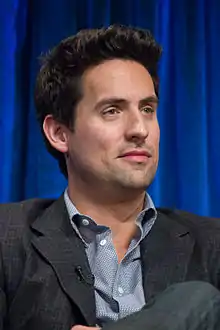
_(48199356311).jpg.webp) Marcelo Arévalo is a professional Salvadoran tennis player
Marcelo Arévalo is a professional Salvadoran tennis player Jaime Alas is a Salvadoran professional footballer
Jaime Alas is a Salvadoran professional footballer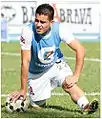 Rodolfo Zelaya is a Salvadoran professional footballer
Rodolfo Zelaya is a Salvadoran professional footballer Rafael Burgos is a Salvadoran professional forward
Rafael Burgos is a Salvadoran professional forward.jpg.webp) Andrés Flores is a Salvadoran professional footballer, who plays for the Portland Timbers in Major League Soccer.
Andrés Flores is a Salvadoran professional footballer, who plays for the Portland Timbers in Major League Soccer._(cropped).jpg.webp) Cristian Roldan is an American professional soccer player, who currently plays as a midfielder for Seattle Sounders FC in Major League Soccer
Cristian Roldan is an American professional soccer player, who currently plays as a midfielder for Seattle Sounders FC in Major League Soccer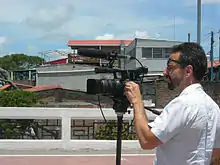 Marcos Villatoro is a writer from the United States. He is the author of six novels, two collections of poetry and a memoir, and the producer/director of the documentary “Tamale Road: A Memoir from El Salvador.”
Marcos Villatoro is a writer from the United States. He is the author of six novels, two collections of poetry and a memoir, and the producer/director of the documentary “Tamale Road: A Memoir from El Salvador.”.jpg.webp) Nayib Bukele is a notable Salvadoran politician and businessman, of Palestinian descent. He became president of the country (2019-2023)
Nayib Bukele is a notable Salvadoran politician and businessman, of Palestinian descent. He became president of the country (2019-2023) Guillermo Hasbún, president of CIFCO
Guillermo Hasbún, president of CIFCO Mario Duran, minister of governance
Mario Duran, minister of governance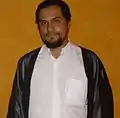 Mustafa Al-Salvadori, president of the shia islamic association
Mustafa Al-Salvadori, president of the shia islamic association Francisco Rubio (astronaut) is a US Army helicopter pilot, flight surgeon, and NASA astronaut candidate of the class of 2017.
Francisco Rubio (astronaut) is a US Army helicopter pilot, flight surgeon, and NASA astronaut candidate of the class of 2017. Johnny Wright is a Salvadoran politician
Johnny Wright is a Salvadoran politician Mauricio Interiano is a Salvadoran politician
Mauricio Interiano is a Salvadoran politician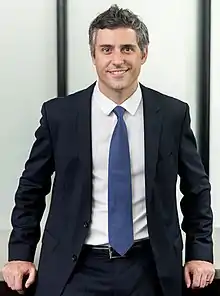 Carlos Calleja is a Salvadoran politician
Carlos Calleja is a Salvadoran politician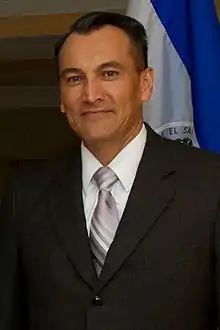 José Atilio Benítez Parada is Salvadoran General, ambassador and former Minister of Defense.
José Atilio Benítez Parada is Salvadoran General, ambassador and former Minister of Defense.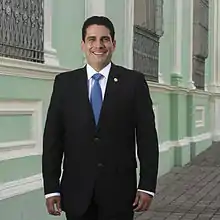 Roberto José d'Aubuisson Munguía is a Salvadoran politician
Roberto José d'Aubuisson Munguía is a Salvadoran politician.jpg.webp) Juan Jose Daboub is the chairman and CEO of The Daboub Partnership, Founding Chief Executive Officer of the Global Adaptation Institute and former managing director of the World Bank (2006–2010)
Juan Jose Daboub is the chairman and CEO of The Daboub Partnership, Founding Chief Executive Officer of the Global Adaptation Institute and former managing director of the World Bank (2006–2010).jpg.webp) Mauricio Funes is a Salvadoran politician who was President of El Salvador from June 1, 2009 to June 1, 2014
Mauricio Funes is a Salvadoran politician who was President of El Salvador from June 1, 2009 to June 1, 2014 Miguel Ángel Pereira, politician
Miguel Ángel Pereira, politician.jpg.webp) José Luis Escobar Alas, Archbishop of San Salvador
José Luis Escobar Alas, Archbishop of San Salvador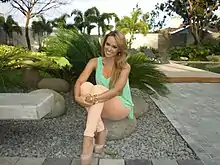 Luciana Sandoval is a Salvadoran presenter, dancer and former model.
Luciana Sandoval is a Salvadoran presenter, dancer and former model.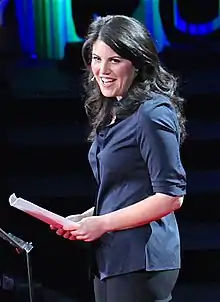
 Denyse Tontz is an American actress, singer, and songwriter.
Denyse Tontz is an American actress, singer, and songwriter..jpg.webp) Ana Villafañe is an actress and singer
Ana Villafañe is an actress and singer Adrian Bellani is an actor
Adrian Bellani is an actor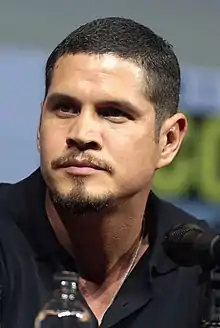 J. D. Pardo is an actor
J. D. Pardo is an actor Francisco Caceres is a TV host and producer. He's currently the Film Expert for Telemundo’s national morning show, Un Nuevo Día based in Miami, Florida
Francisco Caceres is a TV host and producer. He's currently the Film Expert for Telemundo’s national morning show, Un Nuevo Día based in Miami, Florida.jpg.webp) Maurice Benard is an actor who is well k own for playing Sonny Corinthos on the ABC soap opera General Hospital.
Maurice Benard is an actor who is well k own for playing Sonny Corinthos on the ABC soap opera General Hospital. Linda Arsenio is an actress and model
Linda Arsenio is an actress and model Malin Arvidsson is an actor and dancer
Malin Arvidsson is an actor and dancer Somaya Reece is a Salvadoran American hip hop and reality TV star
Somaya Reece is a Salvadoran American hip hop and reality TV star Christy Turlington is an American supermodel. Her mother is from El Salvador. She first represented Calvin Klein's Eternity campaign in 1989 and again in 2014 and also represents Maybelline.
Christy Turlington is an American supermodel. Her mother is from El Salvador. She first represented Calvin Klein's Eternity campaign in 1989 and again in 2014 and also represents Maybelline.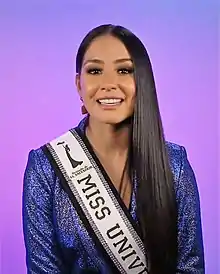 Zuleika Soler, model and beauty pageant titleholder
Zuleika Soler, model and beauty pageant titleholder Sabi (singer) is a Salvadoran-American pop singer, songwriter, dancer and actress from Los Angeles, California. She was formerly part of the hip hop girl group, The Bangz. She is currently signed to Warner Bros. Records.
Sabi (singer) is a Salvadoran-American pop singer, songwriter, dancer and actress from Los Angeles, California. She was formerly part of the hip hop girl group, The Bangz. She is currently signed to Warner Bros. Records. Ana Yancy Clavel is a Salvadorian beauty queen and TV personality
Ana Yancy Clavel is a Salvadorian beauty queen and TV personality Carla Vila is a Salvadoran American actress
Carla Vila is a Salvadoran American actress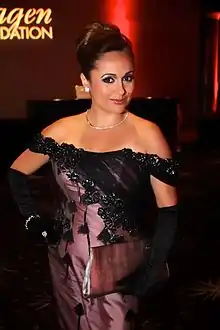 Elizabeth Espinosa reporter and journalist
Elizabeth Espinosa reporter and journalist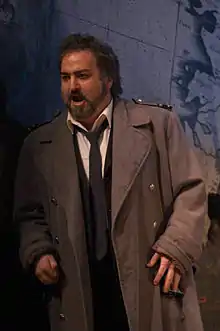 Fernando del Valle is an American operatic tenor.
Fernando del Valle is an American operatic tenor.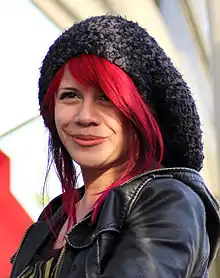 Allison Iraheta is an American singer from Los Angeles, California, who was the fourth place finalist on the eighth season of American Idol.
Allison Iraheta is an American singer from Los Angeles, California, who was the fourth place finalist on the eighth season of American Idol..jpg.webp) Victor R. Ramirez is the current state senator for District 47 in Prince George's County, Maryland
Victor R. Ramirez is the current state senator for District 47 in Prince George's County, Maryland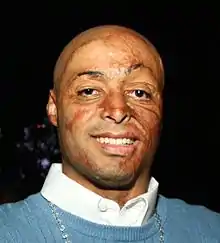 J. R. Martinez is an American actor, motivational speaker and former U.S. Army soldier. Starting in 2008, he played the role of Brot Monroe on the ABC daytime drama All My Children. He is the winner of Season 13 of ABC's Dancing with the Stars. Martinez served as the Grand Marshal of the 2012 Rose Parade. He is currently costarring on the syndicated action series SAF3.
J. R. Martinez is an American actor, motivational speaker and former U.S. Army soldier. Starting in 2008, he played the role of Brot Monroe on the ABC daytime drama All My Children. He is the winner of Season 13 of ABC's Dancing with the Stars. Martinez served as the Grand Marshal of the 2012 Rose Parade. He is currently costarring on the syndicated action series SAF3. Markos Moulitsas is a Salvadoran American that served in the U.S. Army from 1989 through 1992. He is the founder and publisher of Daily Kos, a blog focusing on liberal and Democratic Party politics in the United States. He co-founded SB Nation, a collection of sports blogs, which is now a part of Vox Media
Markos Moulitsas is a Salvadoran American that served in the U.S. Army from 1989 through 1992. He is the founder and publisher of Daily Kos, a blog focusing on liberal and Democratic Party politics in the United States. He co-founded SB Nation, a collection of sports blogs, which is now a part of Vox Media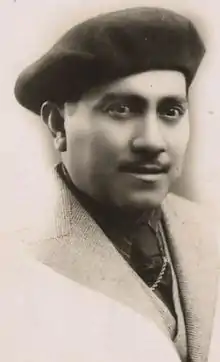 Carlos Irigoyen Ruiz was a renowned Salvadoran musician during the 1920s-1940s.
Carlos Irigoyen Ruiz was a renowned Salvadoran musician during the 1920s-1940s.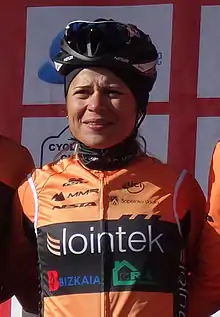 Evelyn García is a Salvadoran cycle racer who rides for the Fenixs team.
Evelyn García is a Salvadoran cycle racer who rides for the Fenixs team.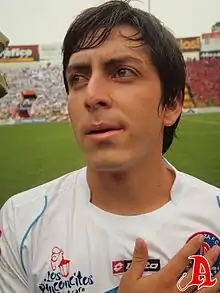 Herbert Sosa is a Salvadoran professional footballer.
Herbert Sosa is a Salvadoran professional footballer. Ricardo Saprissa was a lifelong athlete, coach, and promoter of sports.
Ricardo Saprissa was a lifelong athlete, coach, and promoter of sports..jpeg.webp) Rosemary Casals is a former American professional tennis player
Rosemary Casals is a former American professional tennis player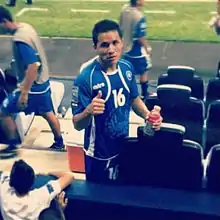 Richard Menjívar is a Salvadoran international footballer currently playing for the New York Cosmos of the North American Soccer League.
Richard Menjívar is a Salvadoran international footballer currently playing for the New York Cosmos of the North American Soccer League.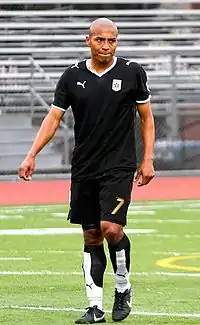 Edwin Miranda grew up in Los Angeles, California and played four years of college soccer at Cal State-Northridge, where he was twice named Big West Conference Defender of the Year.
Edwin Miranda grew up in Los Angeles, California and played four years of college soccer at Cal State-Northridge, where he was twice named Big West Conference Defender of the Year. Hala Ayala is an cybersecurity specialist and democrat politician representing the 51st district in the Virginia House of Delegates.
Hala Ayala is an cybersecurity specialist and democrat politician representing the 51st district in the Virginia House of Delegates.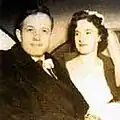 Alicia Nash was a Salvadoran-American physicist. The wife of mathematician John Forbes Nash, Jr.
Alicia Nash was a Salvadoran-American physicist. The wife of mathematician John Forbes Nash, Jr.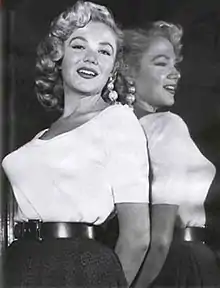 Maribel Arrieta Gálvez was a Salvadoran beauty queen where she represented her country at Miss Universe 1955. Arrieta met Baron Jacques Thuret (of Belgian/French nobility) and both were married in 1963, granting her the title "Baronesa de Thuret".
Maribel Arrieta Gálvez was a Salvadoran beauty queen where she represented her country at Miss Universe 1955. Arrieta met Baron Jacques Thuret (of Belgian/French nobility) and both were married in 1963, granting her the title "Baronesa de Thuret". Consuelo de Saint Exupéry was a Salvadoran-French writer and artist, and the wife of the French aristocrat, writer and pioneering aviator Antoine de Saint-Exupéry (1900–1944).
Consuelo de Saint Exupéry was a Salvadoran-French writer and artist, and the wife of the French aristocrat, writer and pioneering aviator Antoine de Saint-Exupéry (1900–1944).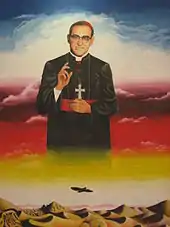 Óscar Romero was a prelate of the Catholic Church in El Salvador who served as the fourth Archbishop of San Salvador. He spoke out against poverty, social injustice, assassinations, and torture. In 1980, Romero was assassinated while celebrating Mass
Óscar Romero was a prelate of the Catholic Church in El Salvador who served as the fourth Archbishop of San Salvador. He spoke out against poverty, social injustice, assassinations, and torture. In 1980, Romero was assassinated while celebrating Mass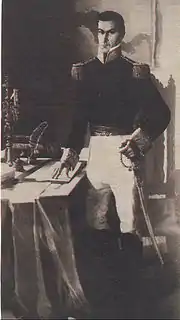 Manuel José Arce was a decorated Salvadoran General and president of the Federal Republic of Central America from 1825 to 1829
Manuel José Arce was a decorated Salvadoran General and president of the Federal Republic of Central America from 1825 to 1829 George Melendez Wright was a biologist who conducted the first scientific survey of fauna for the National Park Service in the United States
George Melendez Wright was a biologist who conducted the first scientific survey of fauna for the National Park Service in the United States Salarrué was a Salvadoran writer, poet and painter
Salarrué was a Salvadoran writer, poet and painter Prudencia Ayala was a Salvadoran writer, first female president candidate in Latin America, and social activist who fought for women's rights in El Salvador.
Prudencia Ayala was a Salvadoran writer, first female president candidate in Latin America, and social activist who fought for women's rights in El Salvador. Farabundo Martí was a Marxist–Leninist activist and a revolutionary leader in El Salvador during the 1932 Salvadoran peasant massacre.
Farabundo Martí was a Marxist–Leninist activist and a revolutionary leader in El Salvador during the 1932 Salvadoran peasant massacre.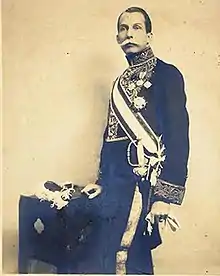 José Gustavo Guerrero was a Salvadoran diplomat and jurist. He served as the last president of the Permanent Court of International Justice from 1937 to 1945; he was also the first president of the International Court of Justice ("World Court") from 1946 to 1949. He help save thousands of Jews from the holocaust
José Gustavo Guerrero was a Salvadoran diplomat and jurist. He served as the last president of the Permanent Court of International Justice from 1937 to 1945; he was also the first president of the International Court of Justice ("World Court") from 1946 to 1949. He help save thousands of Jews from the holocaust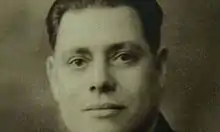 José Castellanos Contreras was a Salvadoran army colonel and diplomat who, while working as El Salvador's Consul General for Geneva during World War II, helped save up to 40,000 Jews
José Castellanos Contreras was a Salvadoran army colonel and diplomat who, while working as El Salvador's Consul General for Geneva during World War II, helped save up to 40,000 Jews.jpg.webp) Roque Dalton was a Salvadoran poet, essayist, journalist, political activist, and intellectual. He is considered one of Latin America's most compelling poets.
Roque Dalton was a Salvadoran poet, essayist, journalist, political activist, and intellectual. He is considered one of Latin America's most compelling poets.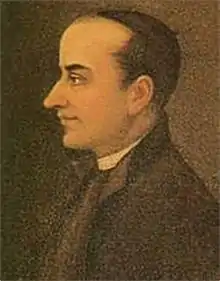 José Matías Delgado was a Salvadoran priest and doctor known as El Padre de la Patria Salvadoreña (The Father of the Salvadoran Fatherland)
José Matías Delgado was a Salvadoran priest and doctor known as El Padre de la Patria Salvadoreña (The Father of the Salvadoran Fatherland)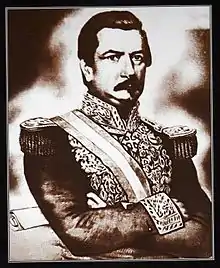 Gerardo Barrios was President of El Salvador, from 12 March 1859 to 26 October 1863
Gerardo Barrios was President of El Salvador, from 12 March 1859 to 26 October 1863_fue_un_cacique_ind%C3%ADgena_de_la_etnia_pipil_de_El_Salvador%252C_uno_de_los_l%C3%ADderes_de_la_Insurrecci%C3%B3n_Campesina_de_1932._Ama_fue_detenido_y_asesinado_durante_ese_levantamiento_ind%C3%ADgena.jpg.webp) Feliciano Ama, indigenous leader
Feliciano Ama, indigenous leader
References
- Campbell, Lyle. (1985) The Pipil language of El Salvador. Mouton to grammar library (no. 1). Berlin: Mouton Publishers.
- Trajes típicos Archived 2008-08-21 at the Wayback Machine
- "Trajes folkloricos de El Salvador". Archived from the original on 2019-05-14. Retrieved 2008-07-29.
- Zielger, Matthew. "El Salvador: Central American Palestine of the West?". The Daily Star. Retrieved 27 May 2015.
- "Lebanese Diaspora – Worldwide Geographical Distribution". Retrieved 27 May 2015.
- "EL SALVADOR, historical demographical data of the whole country".
- The Palestinians of El Salvador at the Wayback Machine (archived 2019-11-13)
- https://newsvideo.su/video/10798241. Missing or empty
|title=(help) - http://theidentitychef.com/2009/09/06/lebanese-diaspora-worldwide-geographical-distribution. Missing or empty
|title=(help) - https://www.chicagotribune.com/news/ct-xpm-2004-03-21-0403210538-story,amp.html. Missing or empty
|title=(help) - "Ed Weeks is Salvadorean on his mother's side!", latina.com. Retrieved 24 August 2014.
- "In Bed With Joan – Episode 9: Ed Weeks". Retrieved 24 August 2014.
